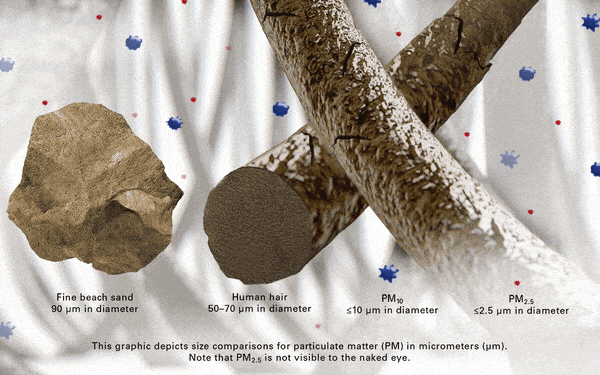Indoor Particulate Matter
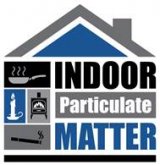
Particulate matter (also referred to as PM or particle pollution) is a complex mixture of solid and/or liquid particles suspended in air. These particles can vary in size, shape and composition. EPA is especially concerned about particles that are 10 micrometers in diameter or smaller because these particles are inhalable. Once inhaled, particles can affect the heart and lungs and in some cases cause serious health effects. The human health effects of outdoor PM are well-established and are used to set health-based standards for outdoor air (National Ambient Air Quality Standards, NAAQS). PM is also found in all indoor environments. Indoor PM levels have the potential to exceed outdoor PM levels and the NAAQS. However, less is known about the specific impacts of indoor PM on health.
On this page:
- Health Effects of Inhalable Particles
- Indoor PM Sources
- Levels of PM Indoors
- Steps to Reduce Exposure to Indoor PM
- Research Activities on Indoor PM
- Additional Resources
On other pages:
- Sources of Indoor Particulate Matter (PM)
- Wildfires and Indoor Air Quality (IAQ)
- Create a Clean Room to Protect Indoor Air Quality During a Wildfire
- For Kids - Air Cleaning Allies
Health Effects of Inhalable Particles
Exposure to inhalable particles can affect both your lungs and your heart. Many studies directly link the size of particles to their potential for causing health problems. Small particles (less than 10 micrometers in diameter) can get deep into your lungs, and some may even get into your bloodstream. People with heart or lung diseases such as coronary artery disease, congestive heart failure, and asthma or chronic obstructive pulmonary disease (COPD), children and older adults may be at greater risk from PM exposure.
Scientific studies have linked PM exposure to a variety of health impacts, including:
- Eye, nose and throat irritation.
- Aggravation of coronary and respiratory disease symptoms.
- Premature death in people with heart or lung disease.
Indoor PM Sources
PM found indoors will include particles of outdoor origin that migrate indoors and particles that originate from indoor sources. Indoor PM can be generated through cooking, combustion activities (including burning of candles, use of fireplaces, use of unvented space heaters or kerosene heaters, cigarette smoking) and some hobbies. Indoor PM can also be of biological origin.
Learn more about important Sources of Indoor Particulate Matter and strategies for reducing them.
Particles in Your Indoor Air and Strategies to Improve Indoor Air Quality
Levels of PM Indoors
Indoor PM levels are dependent on several factors including outdoor levels, infiltration, types of ventilation and filtration systems used, indoor sources, and personal activities of occupants. In homes without smoking or other strong particle sources, indoor PM would be expected to be the same as, or lower than, outdoor levels.
Steps to Reduce Exposure to Indoor PM
- Vent all fuel-fired combustion appliances to the outdoors (including stoves, heaters and furnaces).
- Install and use exhaust fans vented to the outside when cooking.
- Avoid the use of unvented stoves, fireplaces or space heaters indoors. If you must use unvented appliances, follow the manufacturer's instructions, especially related to ventilation.
- Choose properly sized woodstoves, certified to meet EPA emission standards; make certain that doors on all woodstoves fit tightly.
- Use appropriate wood in stoves and fireplaces. Check EPA’s Burn Wise program for Best Wood-burning Practices.
- Have a trained professional inspect, clean and tune-up central heating systems (furnace, flues and chimneys) annually. Repair any leaks properly.
- Change filters on central heating and cooling systems and air cleaners according to manufacturer's directions.
Research Activities on Indoor PM
Health Risks of Indoor Exposures to Fine Particulate Matter and Practical Mitigation Solutions
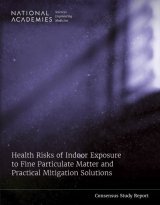
The National Academies of Sciences, Engineering, and Medicine (NASEM) was tasked by EPA to conduct a study on the Health Risks of Indoor Exposures to Fine Particulate Matter and Practical Mitigation Solutions. NASEM convened an expert committee to consider the state-of-the-science on the health risks of exposure to fine particulate matter (PM2.5) indoors and engineering solutions and interventions to reduce those risks, including in residential settings.
The committee’s resulting consensus study report, Health Risks of Indoor Exposure to Fine Particulate Matter and Practical Mitigation Solutions, contains findings and recommendations regarding the key implications of the scientific research for public health, and where additional research will be most critical to understanding indoor exposure to PM2.5 and the effectiveness of interventions.
More information can be found on the consensus study website or by contacting the NASEM by email at Indoor-PM@nas.edu.
Indoor Exposure to Fine Particulate Matter and Practical Mitigation Approaches – Proceedings of a Workshop
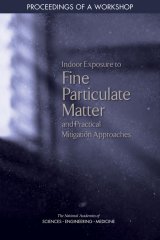
NASEM was tasked by EPA to conduct a workshop on Indoor Exposure to Fine Particulate Matter and Practical Mitigation Approaches in April 2021. The workshop addressed the state-of the-science on exposure to PM2.5 indoors, its health impacts, and engineering approaches and interventions to reduce exposure risks, including practical mitigation solutions, in residential settings. The workshop featured invited presentations and panel discussions on these topics. A summary of the workshop was published in Indoor Exposure to Fine Particulate Matter and Practical Mitigation Approaches: Proceedings of a Workshop, which is available to download for free from the National Academies Press website.
The workshop sought to identify opportunities for advancing research by addressing methodological and technological barriers and enhancing coordination and collaboration between the science, medical, and engineering communities.
More information, including recordings from the workshop, can be found on the workshop website or by contacting the NASEM by email at Indoor-PM@nas.edu.
Evaluating the Health Risks of Indoor Exposure to Particulate Matter, Activities Conducted by the National Academies of Science, Engineering, and Medicine Activities
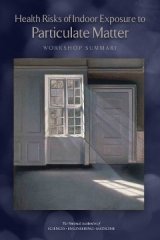
The National Academies of Sciences, Engineering, and Medicine (NASEM) was tasked by EPA to convene a public workshop on February 10-11, 2016, to discuss the state of the science on the health effects of indoor exposure to particulate matter and any associated health impacts. Findings from the workshop are available in the published workshop summary, Health Risks of Indoor Exposure to Particulate Matter. Topics discussed included:
- Sources of indoor particulate matter.
- Particulate dynamics and chemistry.
- Exposure levels and characterization.
- Exposure mitigation.
- Identified and emerging health concerns.
- Interventions and risk communication.
Materials from the workshop are available at the links below:
- Welcome, Workshop Goals, and Introductions - William Nazaroff, Ph.D., Chair
- Sponsor Remarks - David Rowson, U.S. Environmental Protection Agency
- Workshop Summary Report, entitled, Health Risks of Indoor Exposure to Particulate Matter, was released on July 6, 2016.
- Health Risks of Indoor Exposure to Particulate Matter – Summary of a National Academies Workshop and Communicating the Health Risks of Indoor Exposure to Particulate Matter – Challenges and Opportunities presented by David Butler, Guru Madhavan, and George Gray (January 31, 2018)
Additional Resources
- Indoor Air Quality Scientific Findings Resource Bank
- Air Cleaners and Air Filters in the Home
- AirNow
- Burn Wise
- Clean Cookstoves

